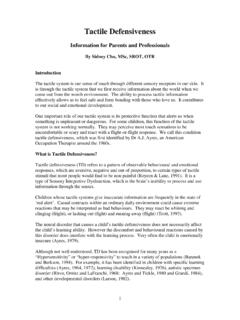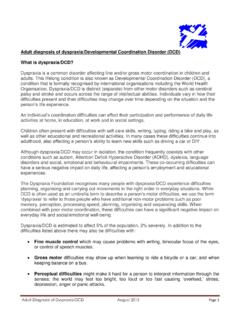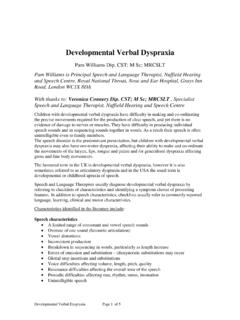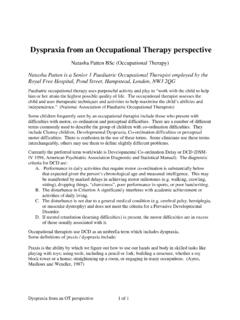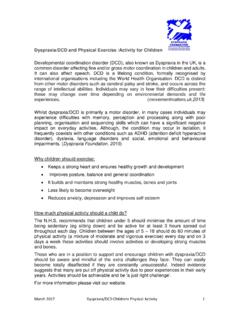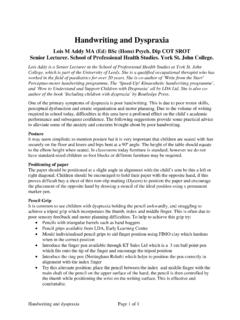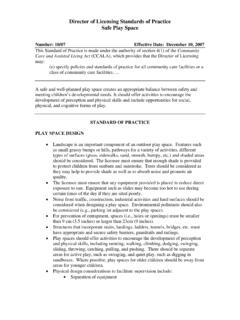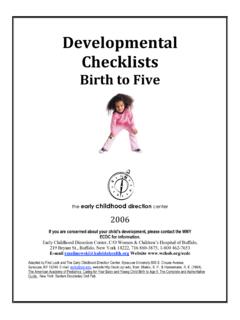Transcription of Developmental Verbal Dyspraxia
1 Developmental Verbal Dyspraxia Pam Williams Dip. CST; M Sc; MRCSLT Pam Williams is Principal Speech and Language Therapist, Nuffield Hearing and Speech Centre, Royal National Throat, Nose and Ear Hospital, Grays Inn Road, London WC1X 8DA With thanks to: Veronica Connery Dip. CST; M Sc; MRCSLT , Specialist Speech and Language Therapist, Nuffield Hearing and Speech Centre Children with Developmental Verbal Dyspraxia have difficulty in making and co-ordinating the precise movements required for the production of clear speech, and yet there is no evidence of damage to nerves or muscles. They have difficulty in producing individual speech sounds and in sequencing sounds together in words. As a result their speech is often unintelligible even to family members. The speech disorder is the predominant presentation, but children with Developmental Verbal Dyspraxia may also have oro-motor Dyspraxia , affecting their ability to make and co-ordinate the movements of the larynx, lips, tongue and palate and /or generalised Dyspraxia affecting gross and fine body movements.
2 The favoured term in the UK is Developmental Verbal Dyspraxia , however it is also sometimes referred to as articulatory Dyspraxia and in the USA the usual term is Developmental or childhood apraxia of speech. Speech and Language Therapists usually diagnose Developmental Verbal Dyspraxia by referring to checklists of characteristics and identifying a symptom cluster of presenting features. In addition to speech characteristics, checklists usually refer to commonly reported language, learning, clinical and motor characteristics. Characteristics identified in the literature include: Speech characteristics A limited range of consonant and vowel speech sounds Overuse of one sound (favourite articulation) Vowel distortions Inconsistent production Breakdown in sequencing in words, particularly as length increase Errors of omission and substitution idiosyncratic substitutions may occur Glottal stop insertions and substitutions Voice difficulties affecting volume, length, pitch, quality Resonance difficulties affecting the overall tone of the speech Prosodic difficulties affecting rate, rhythm, stress, intonation Unintelligible speech Developmental Verbal Dyspraxia Page 1 of 5 Co-occurring characteristics Family history of speech, language or literacy difficulties Delayed language development expressive usually more affected than receptive Delayed development of early speech skills babbling Feeding difficulties Oral Dyspraxia affecting movements of the larynx, lips.
3 Tongue or palate Generalised Developmental Dyspraxia affecting fine and /or gross motor co-ordination Literacy difficulties affecting reading, spelling and writing Slow progress in therapy Literacy difficulties under co-occurring characteristics Developmental Verbal Dyspraxia has been described as an unfolding and changing condition. The range of problems experienced "unfold" as the child progresses and more demands are placed on him. As a result, the presentation of a child with Developmental Verbal Dyspraxia is different according to age and stage of development. Unfortunately, this complicates diagnosis. Help for children with Developmental Verbal Dyspraxia Children with speech difficulties should be referred to a Speech and Language Therapist as early as possible. This can be arranged through a GP or Health Visitor or directly by contacting your local clinic or health centre.
4 The Speech and Language Therapist will be able to assess your child, identify the presenting difficulties and advise on management. Your Speech and Language Therapist will be able to advise whether a label of Developmental Verbal Dyspraxia is appropriate to describe your child's speech difficulties or whether another descriptor is more appropriate. Diagnosis of Developmental Verbal Dyspraxia is complex and often becomes clearer over time. Your therapist may also prefer to describe your child's difficulties rather than assign a label eg "Tom has a severe speech disorder, characterised by typical dyspraxic features, rather than "Tom has Developmental Verbal Dyspraxia ". This is accepted practice within the speech and language therapy profession. It is generally recognised that children with Developmental Verbal Dyspraxia do not get better without help.
5 Usually they require regular, direct therapy delivered by a Speech and Language Therapist, supported by frequent practise outside the therapy sessions at home and /or in school. Speech and Language Therapists use different therapy approaches to treat children with Developmental Verbal Dyspraxia . One popular approach is The Nuffield Dyspraxia Programme (1985; 1992; 2004). It is one of the only published therapy approaches specifically for Developmental Verbal Dyspraxia and is used widely by Speech and Language Therapists in the UK and overseas. It offers a systematic approach to the assessment and treatment of Developmental Verbal Dyspraxia and is particularly suitable for children aged 3-7 years. In the early stages of the Nuffield Dyspraxia Programme, basic oro-motor exercises are advised to help the child develop accurate and rapid movements of all areas of the speech apparatus in preparation for co-ordinating these movements in the production of speech sounds.
6 If you are waiting to see a Speech and Language Therapist or want to start doing something helpful with your child, these oromotor exercises, written by Veronica Connery, Specialist Speech and Language Therapist provide a good starting point: Developmental Verbal Dyspraxia Page 2 of 5 Lips are important for control of dribbling, swallowing and blowing as well as speech sound production. During speech, some sounds, such as sh , w and oo need the lips to move forwards, other sounds such as ee and m need the lips spread. Aims of exercise: to improve lip shapes and movements so that speech sounds can be made more easily. Looking in a mirror Making funny faces Open and shut mouth Make a big mouth like a lion Make a little mouth like a mouse etc. These will make your child more aware of his mouth and how it moves.
7 Blowing and sucking - through different pipes, tubes, straws etc., Helps lips make a rounded shape. Encourage him/her to hold with their lips alone, not with his teeth as well. 2. The Tongue is important for chewing, licking, and swallowing as well as playing a major part in speech production. During speech the separate parts of the tongue (tip, sides, back etc.) must move forwards, backwards, up, down, side to side rapidly for different sound to be produced. Aims of exercise: to improve tongue shape and movements so that it is well controlled and placed accurately for speech sounds. Encourage your child to practise sticking his tongue out this helps to develop a good tip, which is essential for speech sounds. Do this while: Looking in a mirror Licking cooking spoons Licking lollies Try to encourage licking games which help lick downwards onto chin: Lick sideways Lick upwards, especially up behind the teeth.
8 It sometimes helps to emphasise where you want his/her tongue to go if you put his/her finger there and ask him to lick that. NOTE: Tongue movements can be very difficult and you may find these suggestions are not working. If this happens, leave the exercises out and concentrate on other easier areas until the Speech and Language Therapist can advise you. 3. The Soft Palate is difficult to see, this fleshy continuation of the hard palate (roof of the mouth) performs a very important function. It is responsible for the shutting of the nasal passages and so prevents air from the lungs passing up the nasal passages, or food coming down the nose instead of being swallowed. The soft palate adopts this position in blowing, sucking and swallowing activities and should do so for all speech sounds except m , n and ng . If it is not working efficiently, speech will have a nasal quality.
9 Developmental Verbal Dyspraxia Page 3 of 5 Aims of exercise: to encourage easy rapid movements of the soft palate to close off the nasal passages when appropriate in speech. Blowing activities encourage vigorous movements of the soft palate and will help develop muscle strength. If your child finds this very difficult and air comes down his nose, you can help by gently placing your thumb and forefinger under his/her nostrils this will help close off the air stream and give him the feeling of air coming through his mouth and is more pleasant for the child than if you pinch his/her nostrils. Blowing bubbles a wand is difficult so use a simple blower (a variety are available in toy shops) Blow painting through straws can be fun, if messy! Blowing pipes, recorders, harmonicas, etc., is enjoyable and rewarding.
10 Blowing games are often enjoyed and will motivate him to try again various blowing games can be found in toyshops as well as blow football (you can improvise with straws and cotton wool, paper or a table tennis ball). If your child tends to bite too hard on ordinary straws or can t close his/her lips adequately round a straw, try plastic tubing such as that used for wine making. 4. The Larynx (voice box) is responsible for production of sound during speech. The sound is produced by air passing through the vocal chords to produce vibration. If these movements are weak or poorly co-ordinated the voice may be too quiet or loud, the pitch may be too high or low, and the voice may be husky or sound weak. Aims of exercises: to improve the strength and quality of vocal tone. When encouraging your child to use a better voice, it is important to ensure that you do not create vocal strain just asking him to make a louder sound may result in him shouting and becoming even huskier.


